How to Import Pistachios from Iran? | Your 2025 Guide
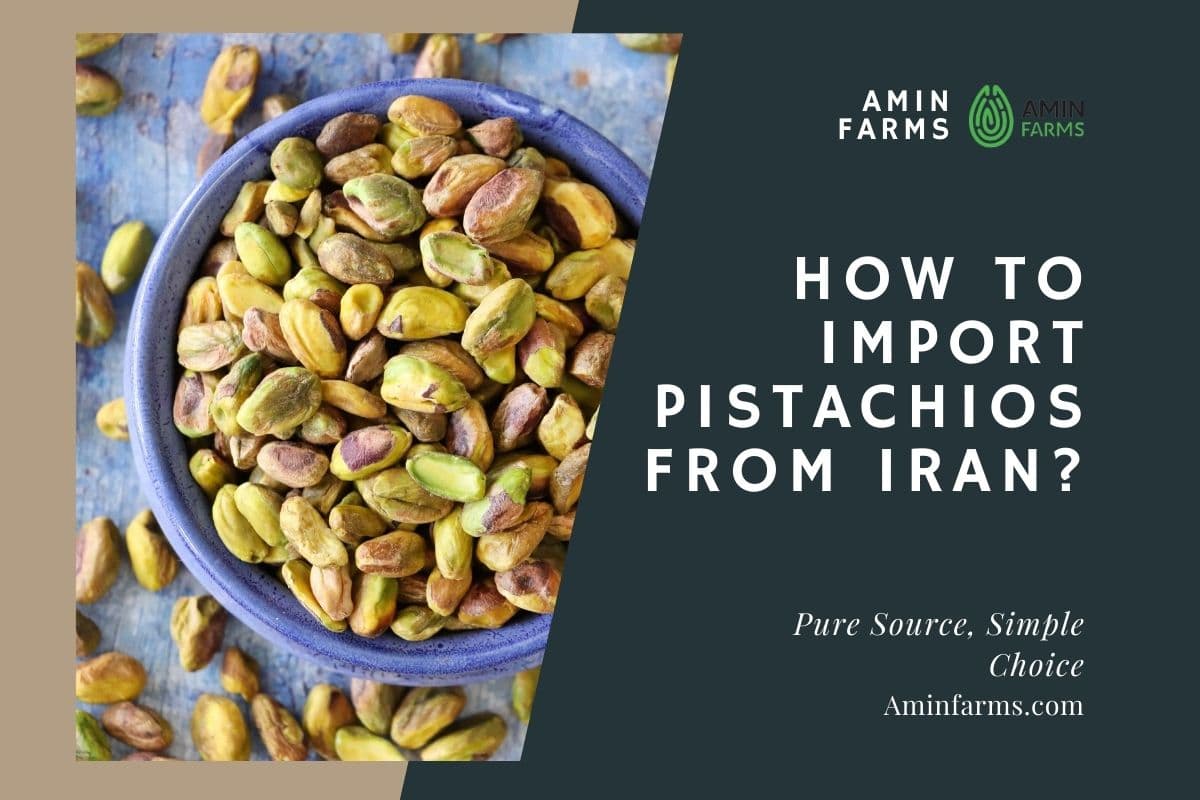
Pistachios, with their bright green kernels and unique flavor, are among the world’s most beloved nuts. Yet, when it comes to quality and reputation, nothing compares to Iranian pistachios.
Known for their exceptional taste, rich aroma, and variety, they hold a special place in global markets. From the elegant Akbari and Ahmad Aghaei to the bold Kalleh Ghouchi and the classic Fandoghi, each type offers its own character that keeps pistachio lovers coming back for more.
Iran is not only one of the largest producers but also a leading exporter of pistachios worldwide. This makes pistachio imports from Iran an attractive opportunity for businesses looking to tap into a profitable and growing market. However, like any international trade, the process can initially feel overwhelming. From choosing the right variety for your target customers to navigating regulations and logistics, every step requires attention and reliable information.
If you have ever wondered how to import pistachios from Iran, the journey begins with learning the basics. By understanding the product, recognizing market demand, and collaborating with trusted suppliers, you can transform this opportunity into a successful business. Keep reading to discover exactly how to import pistachios from Iran with confidence.
Essential Steps to Import Pistachios from Iran
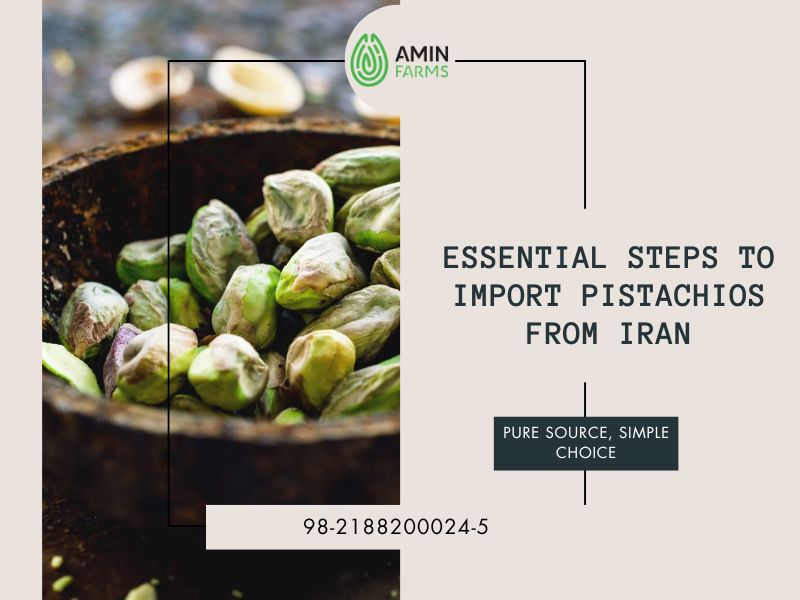
Importing pistachios from Iran can be a smart business move, but success depends on knowing the proper steps. The Pistachio import process from Iran involves market research, legal preparation, and smooth logistics. If you’ve ever asked yourself how to import pistachios from Iran, the following guide breaks it down into clear and practical stages.
1. Market Research and Choosing a Supplier
Start by analyzing your target market. Understand what type of pistachios customers prefer—Akbari, Fandoghi, or Kalleh Ghouchi. Once you know the demand, find a reliable Iranian supplier with proven experience and the required export licenses. Trustworthy partners are the foundation of a smooth import process.
2. Legal Requirements and Documentation
Importing is not just about buying and selling—it’s also about compliance. You’ll need import permits from your country, as well as essential paperwork such as the commercial invoice, packing list, certificate of origin, and a health certificate. Being prepared prevents costly delays at customs.
3. Shipping and Logistics
The final step is choosing how to transport your pistachios. Options include sea, air, or land freight. Work with a reputable logistics company to handle customs clearance and ensure timely delivery. Proper planning here will keep your products fresh and your business stress-free.
Navigating Iranian Export Regulations
When it comes to pistachio trading, knowing the rules is just as important as finding the right supplier. Import regulations for nuts from Iran are designed to guarantee quality and safety, and every successful importer needs to be aware of them.
The Iranian government requires exporters to obtain health and quality certificates from official organizations such as the Food and Drug Administration and the Standards Organization. These documents confirm that the pistachios meet strict requirements, including being free from aflatoxins and other harmful substances.
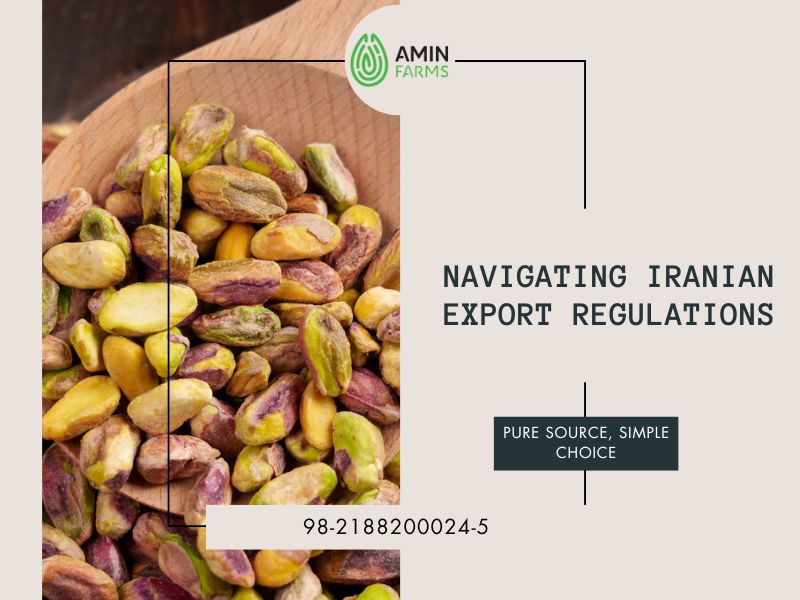
Exporters must also comply with customs regulations and accurately declare their goods. If these steps are not followed, shipments may face delays or, in the worst case, be seized. That’s why partnering with a reliable and experienced exporter is essential.
A professional exporter knows how to prepare all the necessary paperwork, including the commercial invoice, packing list, and certificate of origin. These documents are not only required for customs clearance at the destination but also serve as proof of a legal and transparent trade process.
For anyone wondering how to import pistachios from Iran, the answer begins with compliance. By choosing a trustworthy partner and adhering to export regulations, you can ensure a smooth and successful pistachio import journey.
Top Quality Checks for Iranian Pistachios
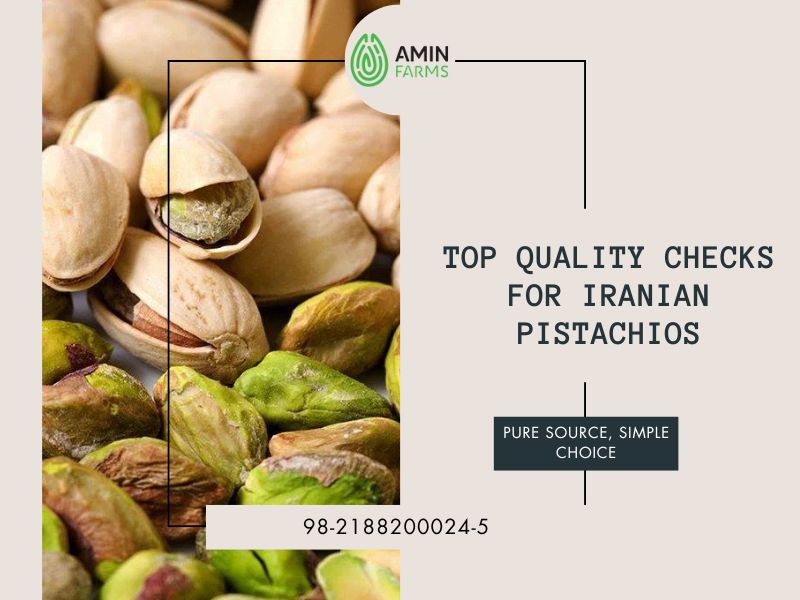
When planning to import pistachios from Iran, one of the most critical steps is ensuring the product meets international quality standards. Careful quality checks at the source can save you from financial loss and ensure your customers receive only the best pistachios. Here are the key factors to focus on.
1. Aflatoxin levels
Aflatoxin is a toxic substance that can sometimes develop in pistachios. In Iran, levels are strictly monitored by the Standards Organization and the Food and Drug Administration. Before purchasing, always request health certificates and lab test results from the exporter to ensure the pistachios are safe.
2. Size and appearance
Quality pistachios should have whole, green kernels with no cracks or damage. Size also matters; pistachios are graded by “ounce count,” and the lower the number, the larger and more premium the nuts.
3. Moisture and taste
The moisture content must remain within the approved range to prevent mold growth. A high-quality pistachio should taste naturally fresh, never bitter, sour, or musty.
Working with trusted Iranian pistachio suppliers is the best way to ensure these standards are met. By prioritizing quality checks, you not only protect your investment but also build a reputation for delivering top-grade pistachios to your market.
Ensuring Freshness and Compliance
Buying pistachios from Iran involves more than simply checking their quality. To succeed in the market, you also need to ensure freshness and compliance with international health standards. Proper storage and packaging are key.
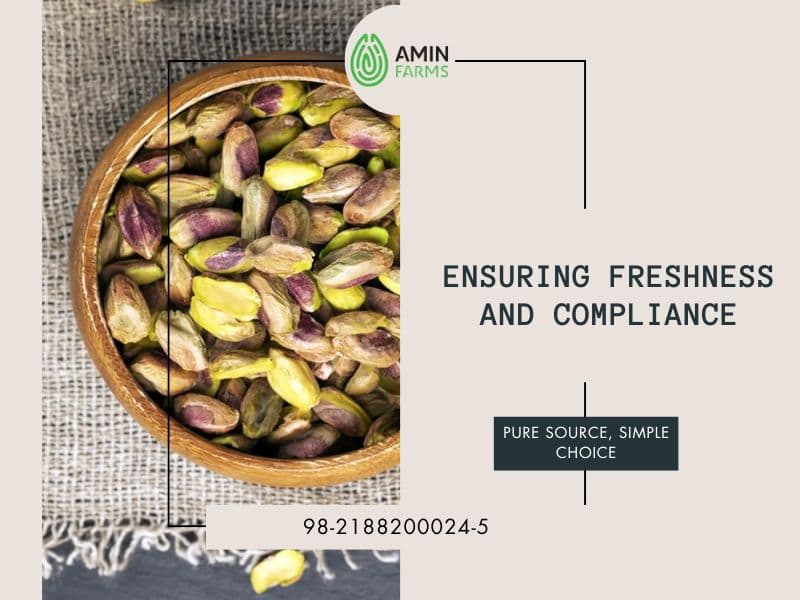
Pistachios should be shipped under the right conditions to protect them from moisture, heat, and possible contamination. Vacuum-sealed packaging or multilayer bags are often the best options for preserving freshness and preventing spoilage.
Equally important are the health and safety certificates provided by the exporter. These documents confirm that the pistachios meet strict international standards, including safe levels of aflatoxin and other potential contaminants. A reliable exporter will always supply the necessary paperwork without hesitation.
If you’ve ever wondered how to import pistachios from Iran, the answer lies in working with trusted partners, securing proper documentation, and never compromising on freshness or quality. This is how you achieve sustainable growth in this business.
Finding Reliable Iranian Pistachio Suppliers
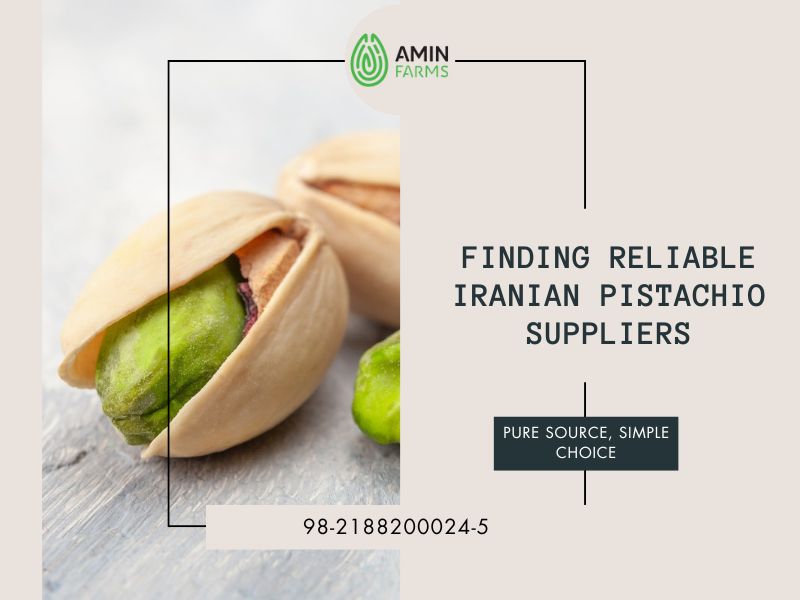
Finding a reliable partner is the most crucial step in successful pistachio import. A trusted exporter not only delivers high-quality products but also helps with documents, logistics, and every stage of the process. If you’ve ever wondered how to import pistachios from Iran, the journey begins with choosing the right supplier.
1. Online research and B2B platforms
Websites like Vitfa or Iran Sources can be a helpful starting point to connect with Iranian pistachio suppliers. These platforms allow you to review company profiles, track records, and customer feedback. However, caution is essential; avoid unknown or unverified sellers to reduce risk.
2. Attending trade fairs
International food and agriculture exhibitions, whether in Iran or abroad, offer excellent opportunities to meet pistachio exporters in person. Seeing the products in person and building direct relationships adds trust and long-term value to your business.
3. Working with inspection and consulting firms
In Iran, independent auditors or trade advisors can point you toward reliable suppliers. They can also verify documents and product quality, significantly lowering the risks of import and giving you peace of mind.
Logistics and Costs for Global Imports

Importing pistachios from Iran is a rewarding opportunity, but it comes with several costs and considerations. To make the process profitable, it’s essential to understand the logistics and financial aspects involved. If you’ve ever wondered how to import pistachios from Iran, here are the key factors you need to plan for.
Shipping and insurance
Transportation costs vary depending on the method you choose: sea, air, or land. Sea freight is typically the most cost-effective option for large volumes, while air freight is better suited for smaller shipments that require fast delivery. Don’t forget insurance, which protects your goods in case of damage or loss during transit.
Customs duties and taxes
Every country has its own import rules. You’ll need to account for customs duties, VAT, and other local taxes. Failing to address these can result in delays at customs and unexpected expenses. For example, pistachio export to India requires specific paperwork and compliance with local food safety regulations.
Hidden and additional costs
Beyond the main expenses, there are additional charges, including product inspections at origin or destination, warehousing, customs clearance services, and bank fees for international transfers.
Why Import Pistachios from Iran in 2025?
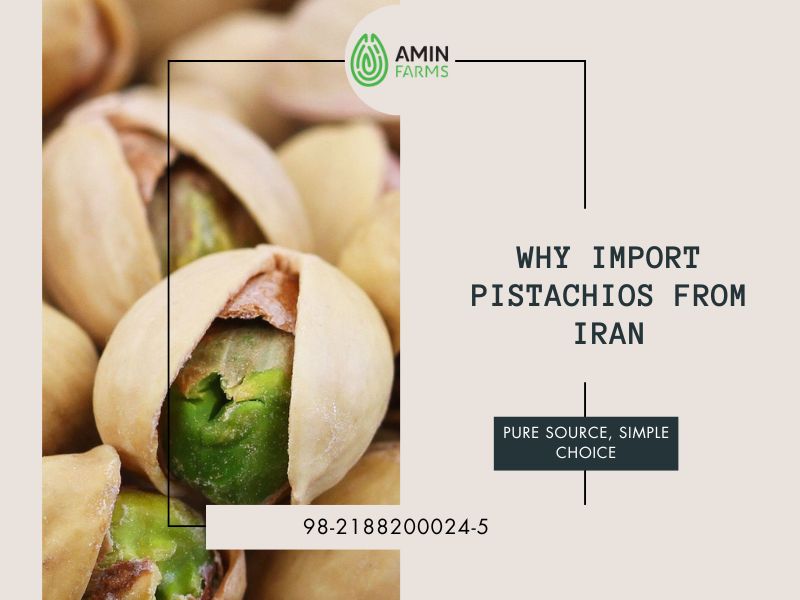
In 2025, importing pistachios from Iran is more than just a trade option; it’s a brilliant business opportunity. If you’ve ever wondered how to import pistachios from Iran, understanding why this product is so valuable is the first step. Let’s explore the main reasons why importing pistachios from Iran can give you a strong advantage in global markets.
1. Exceptional Quality and Variety
With their rich flavor, striking color, and recognizable shape, Iranian pistachios are genuinely one of a kind. With varieties such as Akbari, Ahmad Aghaei, Kalleh Ghouchi, and Fandoghi, importers can always find a product that meets their market’s needs.
2. Rising Global Demand
As people become more aware of the health benefits of pistachios, global demand continues to rise. From healthy snacking to use in desserts and gourmet dishes, pistachios are now a staple in many industries.
3. Competitive Advantage
Iran stands out with premium quality at competitive prices. Modern processing and packaging techniques ensure the freshness of Iranian pistachios, making them highly attractive to global buyers.
4. Access to New Markets
As Iran expands its trade partnerships, importers can tap into emerging markets and strengthen their global position.
5. Stable Production and Supply
Thanks to decades of farming experience and robust infrastructure, Iran offers a stable pistachio supply, mitigating risks for importers and facilitating long-term business planning.
Partner with Amin Farms for Seamless Pistachio Imports
In the complex world of pistachio imports, choosing the right business partner can make all the difference. Amin Farms, with years of experience in growing, processing, and exporting pistachios, has established itself as one of the most trusted choices for international buyers.
If you’ve ever wondered how to import pistachios from Iran, working with a reliable supplier is the first step, and that’s where we come in.
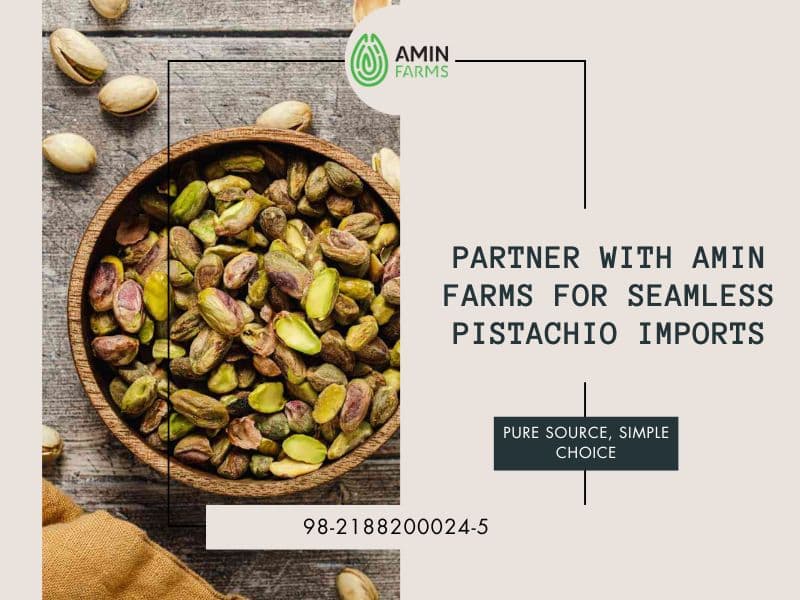
At Amin Farms, we source pistachios directly from our own orchards. This allows us to oversee every stage of production, from planting and harvesting to processing and packaging. Each batch goes through rigorous quality checks to ensure it meets the highest international standards for safety and freshness.
More than simply being an Iranian pistachio supplier, we act as a trusted partner in your business. Our experienced team handles every part of the export process for you, including legal documents, health certificates, logistics, and customs clearance, so you don’t have to worry about the details.
By partnering with Amin Farms, you can focus on growing your business with peace of mind, knowing that your pistachio supply is managed with professionalism, transparency, and care.
